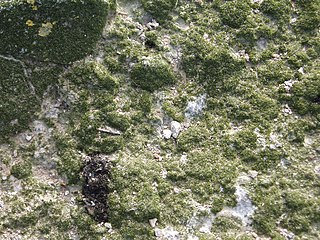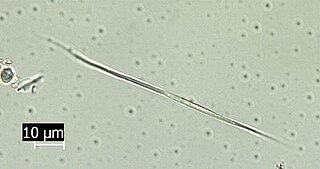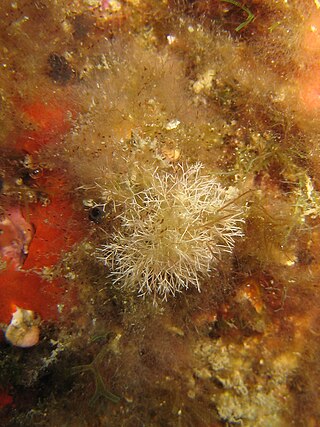
Nodularia is a genus of filamentous nitrogen-fixing cyanobacteria, or blue-green algae. They occur mainly in brackish or salinic waters, such as the hypersaline Makgadikgadi Pans, the Peel-Harvey Estuary in Western Australia or the Baltic Sea. Nodularia cells occasionally form heavy algal blooms. Some strains produce a cyanotoxin called nodularin R, which is harmful to humans.

Oscillatoria is a genus of filamentous cyanobacteria. It is often found in freshwater environments. Its name refers to the oscillating motion of its filaments as they slide against each other to position the colony to face a light source. Oscillatoria uses photosynthesis to survive and reproduce. Each filament of Oscillatoria consists of a row of cells called a trichome. The tip of the trichome oscillates like a pendulum.

Halimeda is a genus of green macroalgae. The algal body (thallus) is composed of calcified green segments. Calcium carbonate is deposited in its tissues, making it inedible to most herbivores. However one species, Halimeda tuna, was described as pleasant to eat with oil, vinegar, and salt.

Moorea producens is a species of filamentous cyanobacteria in the genus Moorea, including tropical marine strains formerly classified as Lyngbya majuscula due to morphological resemblance but separated based on genetic evidence. Moorea producens grows on seagrass and is one of the causes of the human skin irritation seaweed dermatitis. It is known as fireweed in Australia and stinging limu in Hawaii.

Prasiolales is an order of green algae in the class Trebouxiophyceae. Members of this order are ecologically widespread and are found in freshwater, marine, and terrestrial habitats from the Arctic to the Antarctic.

Oocystaceae is a family of green algae, in the class Trebouxiophyceae. Molecular phylogenetic studies mostly place the family in the order Chlorellales, as sister to Chlorellaceae. The type genus is Oocystis.

Dictyosphaerium is a genus of green algae, in the family Chlorellaceae. It occurs in freshwater habitats around the world and is planktonic. The name comes from the Greek roots diktyon, meaning "net", and sphaira, meaning "ball", referring to its morphology.

The Rivulariaceae are a family of cyanobacteria within the Nostocales in which the filaments (trichomes) are tapered from wider at the base to narrower at the tip.

Halymenia a genus of a macroscopic red algae that grows in oceans worldwide.

Planktothrix is a diverse genus of filamentous cyanobacteria observed to amass in algal blooms in water ecosystems across the globe. Like all Oscillatoriales, Planktothrix species have no heterocysts and no akinetes. Planktothrix are unique because they have trichomes and contain gas vacuoles unlike typical planktonic organisms. Previously, some species of the taxon were grouped within the genus Oscillatoria, but recent work has defined Planktothrix as its own genus. A tremendous body of work on Planktothrix ecology and physiology has been done by Anthony E. Walsby, and the 55.6 kb microcystin synthetase gene which gives these organisms the ability to synthesize toxins has been sequenced. P. agardhii is an example of a type species of the genus. P. agardhii and P. rubescens are commonly observed in lakes of the Northern Hemisphere where they are known producers of potent hepatotoxins called microcystins.

Lyngbyatoxin-a is a type of alkaloid cyanotoxin produced by certain cyanobacteria species, most notably Moorea producens. It is produced as defense mechanism to ward off any would-be predators of the bacterium, being a potent blister agent as well as carcinogen. Low concentrations cause a common skin condition known as seaweed dermatitis.

Lyngbya majuscula is a species of filamentous cyanobacteria in the genus Lyngbya. It is named after the Dane Hans Christian Lyngbye.

Lobophora is a genus of thalloid brown seaweed of the Phylum Ochrophyta; Class Phaeophyceae.
Trichodesmium thiebautii is a cyanobacteria that is often found in open oceans of tropical and subtropical regions and is known to be a contributor to large oceanic surface blooms. This microbial species is a diazotroph, meaning it fixes nitrogen gas (N2), but it does so without the use of heterocysts. T. thiebautii is able to simultaneously perform oxygenic photosynthesis. T. thiebautii was discovered in 1892 by M.A. Gomont. T. thiebautii are important for nutrient cycling in marine habitats because of their ability to fix N2, a limiting nutrient in ocean ecosystems.

Koliellaceae is a family of green algae in the order Prasiolales.

Dictyota is a genus of brown seaweed in the family Dictyotaceae. Species are predominantly found in tropical and subtropical seas, and are known to contain numerous chemicals (diterpenes) which have potential medicinal value. As at the end of 2017, some 237 different diterpenes had been identified from across the genus.

Stylocheilus striatus is a species of sea hare found in the Indo-pacific region living from the intertidal zone to a depth of 30 metres. Common names include lined sea hare, blue ring sea hare and furry sea hare. Mature animals can reach sizes of up to 65 mm in length and are brown in colour with blue spots. Their diet mainly consists of blue algae. They play an important role in controlling toxic blooms of the cyanobacterium Lyngbya majuscula.
Roseofilum reptotaenium, also called coral killer, is a filamentous species of cyanobacteria. It is the pathogenic agent responsible for black band disease on Siderastrea siderea coral.

Aphanothece is a polyphyletic genus with 63 accepted species. The name is derived from the Greek words, ‘aphanes’ and ‘theke’ which mean “invisible" and “box or sheath” respectively. This genera is cosmopolitan, found in soils, thermal springs and other benthic, freshwater, marine, hypersaline, and moist terrestrial environments. Morphology can vary, with both microscopic and macroscopic colonies large enough to be collected and preserved in herbarium records.

Liagoraceae is a family of red algae (Rhodophyta) in the order Nemaliales. The type genus is LiagoraJ.V.Lamouroux.


















